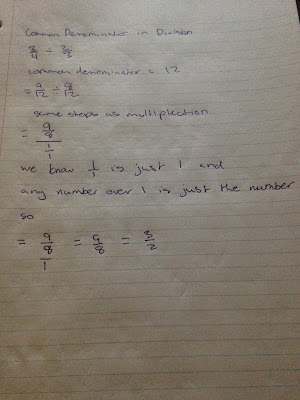Last week we continued with fractions, continuing to make them less and less complicated for ourselves and later our students. I guess you can say this is the second 1/2 to the lesson (see what I did there).
One of the big topics this week was division of fractions, pretty scary as we approach Halloween. But of course, there is always a simpler way to do things than the way we have been taught. Most of us had been taught that you only find a common denominator for multiplication of fraction right? Well despite being told no you can't do it, you can actually find a common denominator to help divide fractions easier. When I first heard this of course I was thinking, no not possible I haven't been taught that way. Well consider the following problem. I will go through step by step how to solve it.
Maintaining an open mind when coming to class is really important when attempting to understand new concepts. For someone like myself, I find that extremely hard, I guess you could say I am fairly close-minded when it comes to certain things. I am working really hard to fix that because I want to show my students all the ways to solve different problems because teaching them one way will not be enough for some learners. Every student is different and many of them will not learn the same way as the other so its important to understand different ways to find the same answer. It will help you personally become a better teacher.
Continuing with the lesson we also reviewed six steps to creating an open question, a question that allows the learner to make decisions. These six steps are:
1. Begin with answer.
2. Ask for similarities.
3. Leave certain information out of the problem.
4. Provide several numbers and math words. The students will have to create the problem using the numbers and words.
5. Use soft language.
6. Prove that an idea is true or false.
A simple example would be using the number 43 and the word sum, create a work problem that has fraction as the answer. An answer could be Jimmy has 21 green apples and 22 red apples that add to a sum of 43 apples total, he has 21/43 green and 22/ 43 red which can be expressed as a ratio of 21:22.
Overall the lesson was really great, I learned another new concept which I look forward to applying in my classroom during my placement block.

No comments:
Post a Comment